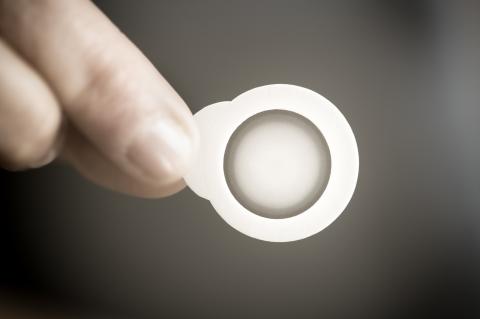Hunting for antiques and salvaged stone and wood is easy on the environment and the wallet. And done the right way, it’s smart for asthma, too.
Joanne Palmisano jokes that, for someone with serious allergies to dust and mold – not to mention horses, mice and more – she might not have chosen the best line of work.
The award-winning interior designer, home stylist and author regularly scours dusty old antique shops, flea markets, yard sales, second-hand stores, architectural salvage sales and even garages and barns, looking for that perfect find.
“My husband says, ‘Of all things to choose as a business, you go into old barns and salvage stuff where you’re allergic to almost everything,” she recounts with a laugh. “And when I go into old barns and buildings, sometimes I can only stay for a short time, so I have to plan ahead.”
But there’s a reason that Palmisano suffers through symptoms: for her design clients, she regularly blends old and new to create stunning, one-of-a-kind interiors – and although shopping for used items can have pitfalls for people with allergies, there are some big allergy upsides, too.
In With the Old
When it comes to buying items that are used, or that are salvaged from home or building demolitions, there are plenty of advantages: they’re usually cheaper, they’re better for the environment, and, from elegant library tables to sleek ceramic tile to glittery chandeliers, you can pick up goods that have far more style and character than what you’ll find at a big box retailer.
But for people with asthma and allergies, there’s one more big advantage: you can buy items that are crafted from natural materials such as solid wood, leather, stone and tile that won’t gather mold and dust, or emit asthma-triggering volatile organic compounds (VOCs) as some goods made from vinyl, laminate or particle board do – and you can pick them up or a fraction of the price that you would pay new. To boot, when you buy used, most coatings and sealants will have already finished releasing (or off-gassing), those harmful VOCs.
Palmisano’s favorite things to pick up second-hand include stone, which she can cut to size and re-purpose as flooring, counter tops, back splashes and more; recycled glass tile, which is very allergy-friendly; solid wood furniture, especially Danish modern which comes with simple, elegant lines and is easy to clean and re-coat; light fixtures, which can add sparkle to a room without upping the allergy load; and decorative items from vases to wood picture frames.
“It’s usually amazing quality,” says Palmisano, who has created dozens of projects for the DIY Network and has authored two books, Salvage Secrets: Transforming Reclaimed Materials into Design Concepts and Salvage Secrets Design & Decor.” And the character of salvaged, vintage, antique and recycled material is truly something you can’t find as much in new materials.”
The Deal Breakers
But before you hit those salvage sales and antique shops, it’s important to remember that not all used items are a good idea.
For allergic shoppers, two of the biggest deal breakers are mold and dust mites. Palmisano usually steers clear of used rugs because they provide a perfect home for those potent allergens and others, and they’re almost impossible to properly clean. For the same reason, she also recommends avoiding upholstered furniture – unless you’re ready to strip it right down to the frame and replace the cushions as well as the fabric. Watch out as well for the scent of mold in other items, from books to fabrics, as they can be too far gone to bring home.
With old wood, it’s important to watch that it can be cleaned and resealed, and that boards are not showing signs of rot. And while many people love the look of rustic wood floors, with allergic clients, Palmisano only uses wood that can be sealed and laid tightly with each piece butting against the next. Otherwise the wood will shrink and those natural-looking gaps will fill up with dust, mold and other allergy and asthma triggers.
Other deal-breakers include any items that may have lead paint (you can pick up an inexpensive testing kit at most home reno stores), old plumbing fixtures (they can also contain lead), old toilets, old tubs that have rusted, and anything that has too much damage. The U.S. government also warns consumers away from buying used cribs, high chairs, car seats and baby gates, because they can pose a safety hazard.
“But for me there is almost never an issue of no-go, because I repurpose a lot,” says Palmisano. “I’ll buy an old crib and use the base as a wall hanging, or I’ll use old stair railings that are no longer up to code as Candlesticks. You could even buy a beautiful vintage rug and just frame it in glass and put in on your wall, and you don’t have an allergy issue. You just have to see it in a different way.”
Where to Shop
Of course, before you can see it in a different way, you have to find it – and whether she’s at home in Vermont or traveling the country on a speaking tour, Palmisano always searches online for the best second-hand stores, antique shops and architectural salvage businesses, then hits the bricks in search of the next big find.
The designer also travels with large plastic bags so she can completely contain the items until she can properly clean them; that way the dust and mold don’t get released in her home, her car or her hotel room.
(One of her biggest scores was a stunning, seven-foot oak library table that she and her husband landed at a going out of business sale. It was a retail store, and she was eyeing all the stuff sitting on the table; but her husband wisely asked how much for the table itself. To their amazement, the salesperson answered, “50 bucks.”)
So how to find the best stops? Often if you Google phrases like “best antique shops” or “best second-hand stores” and the name of your city, or look on ratings websites such as Yelp, you can find suggestions for favorite businesses in your area. It’s also worth checking out ReStore, whose profits help to fund Habitat for Humanity’s house-building initiatives. The chain sells new or gently used construction materials, home furnishings, appliances and decor that would otherwise end up in the landfill. And of course, classified websites such as Craigslist are a gold mine for second-hand shoppers.
But Palmisano says that, no matter where you go, the key to becoming a salvage pro is to shop often and really look around, even if you don’t buy, because you’ll get better at spotting hidden gems, and you’ll know when the price is right.
“Continue to look and see what you like, and see what things sell for. So when there’s that chandelier you loved, loved, loved and you’ve only seen for $1,000 in five places, and all of a sudden you see it for $200, you’ll know it’s a great deal,” she says. “It’s just really educating yourself on what’s out there, what’s a good price, and what it’s going to cost you to get it in your house.”
Then, when you bring those great finds home, Palmisano recommends meticulously cleaning them and carefully resealing any items made from wood before you bring them into your home; otherwise you run the risk of bringing dust, mold and other allergens in with them.
Feeling the Joy
Author and healthy home advocate Debra Lynn Dadd, whom The New York Times dubbed “The Queen of Green,” is also a huge proponent of buying quality used and salvaged items because they’re better for the planet, for people’s health, and for their budgets.
Along the way she’s picked up $800 worth of stunning ceramic tile for $80, transformed an elegant old sewing table into a kitchen island, and bought a beautifully made sofa frame for $50 and had it reupholstered exactly to her taste for $1,500. She also managed to score a leather-covered lawyer’s wood desk for $50 – only to find that underneath the weathered leather, it was solid mahogany.
Dadd emphasizes that you don’t even need to leave your home to design with salvaged items. Entire kitchens can be transformed by keeping the existing cabinets and simply swapping out the doors. Dadd also repurposes all kinds of items; for example, she saved a piece of iron work from an old wood door, built a frame around it and turned it into an entrance gate.
“I’m just so disappointed with most new industrial products because they’re toxic, and they’re also not very creative. They’re not very beautiful; they’re just industrial,” she says. “When people come in my house, they say ‘You have such beautiful things.’ And I do.”
Dadd’s advice? Don’t bring anything home that contains VOCs or other toxins – particle board, plywood, and anything containing lead are a few of her deal breakers. Also, do the math: she counsels looking past the price tag and calculating the cost of bringing each item back to life, because it’s not always worth it. Also, make sure to have a clear plan for each piece before you buy; otherwise it might just become one more thing gathering dust in your garage.
But when Dadd does the math, she doesn’t factor in the cost of her and her husband’s time – and together they have transformed an old oak Stanford library table into a stunning desk, overhauled their kitchen, and built a floor-to-ceiling cabinet, to name just a few of their many projects. (And one day, whoever removes that cabinet will find a hidden note from Dadd’s husband explaining that he built it especially for his wife.) Theirs is a labor of love.
“I always look at the joy of doing the creating as part of the benefit. I’m looking at it as a fun project for us to create together. So I don’t need to be compensated for that because I’m already compensated by the joy of it – and the joy of having what I want, having something unique and having something beautiful.
“It’s like a work of art,” she says. “So I don’t count that as an expense. I count that as a boon.”








